NSG3TCN Assignment: Nursing Case Study Analysis of Patient Care
VerifiedAdded on 2023/01/20
|13
|3701
|29
Case Study
AI Summary
This document presents a detailed analysis of four nursing case studies, focusing on patients experiencing various health issues and deteriorating conditions. Each case study examines the pathophysiology of the patient's condition, including diagnoses such as heart failure, respiratory distress, hypovolemic shock, pneumothorax, and post-operative pain. The analysis includes the rationale behind the diagnoses and the necessary nursing actions required to address the patients' needs, such as administering medications, providing oxygen therapy, monitoring vital signs, and managing drainage systems. The cases also highlight professional issues that nurses may encounter, such as adhering to NMBA and NSQHS standards, obtaining consent, and escalating concerns to supervisors. The assignment emphasizes patient-centered care, clinical communication, medication safety, and the importance of responding effectively to deteriorating patient conditions, referencing relevant literature and professional standards throughout the analysis.

Running head: NURSING CASE STUDY
NURSING CASE STUDY
Name of the Student
Name of the University
Author Note
NURSING CASE STUDY
Name of the Student
Name of the University
Author Note
Paraphrase This Document
Need a fresh take? Get an instant paraphrase of this document with our AI Paraphraser
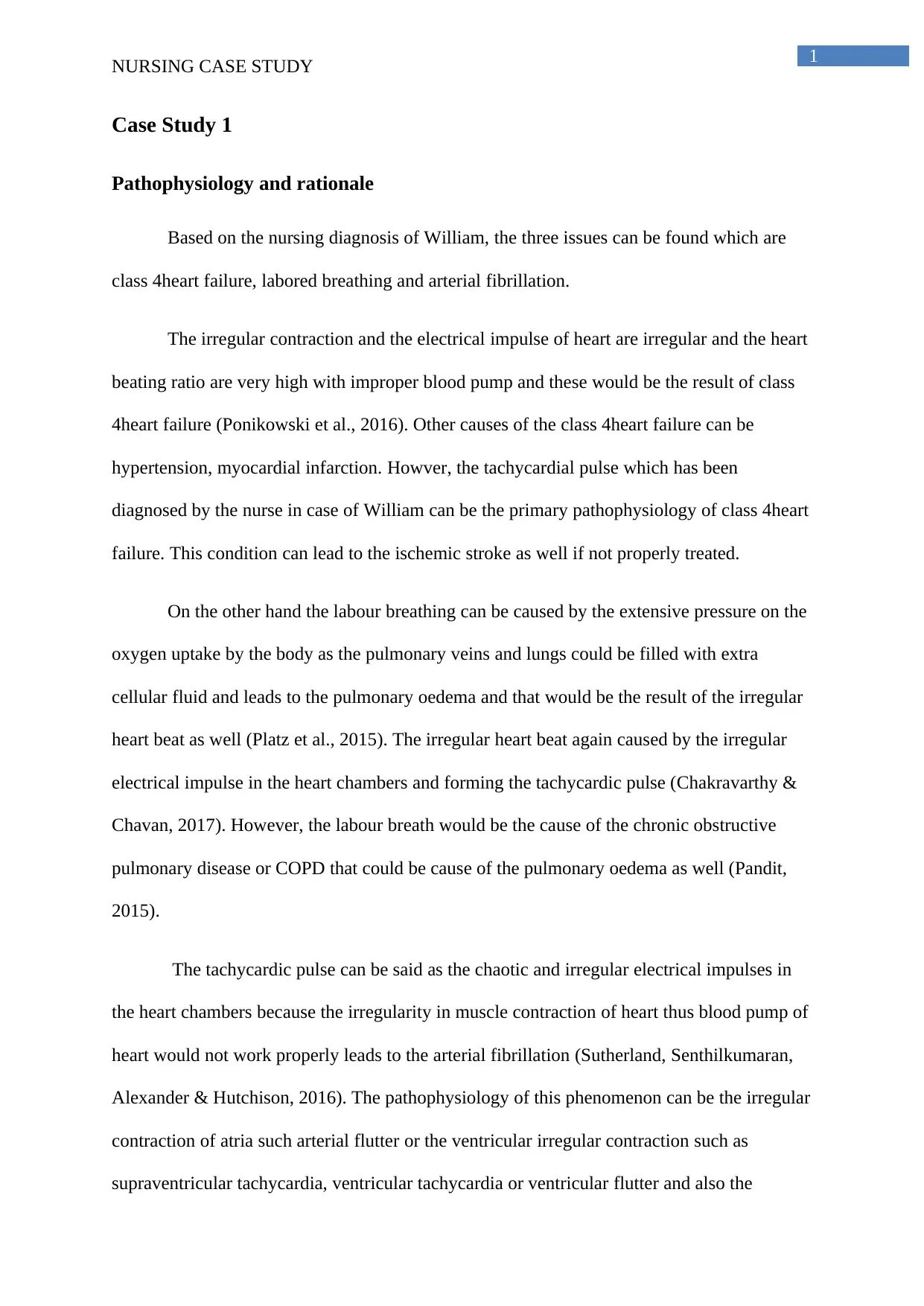
1
NURSING CASE STUDY
Case Study 1
Pathophysiology and rationale
Based on the nursing diagnosis of William, the three issues can be found which are
class 4heart failure, labored breathing and arterial fibrillation.
The irregular contraction and the electrical impulse of heart are irregular and the heart
beating ratio are very high with improper blood pump and these would be the result of class
4heart failure (Ponikowski et al., 2016). Other causes of the class 4heart failure can be
hypertension, myocardial infarction. Howver, the tachycardial pulse which has been
diagnosed by the nurse in case of William can be the primary pathophysiology of class 4heart
failure. This condition can lead to the ischemic stroke as well if not properly treated.
On the other hand the labour breathing can be caused by the extensive pressure on the
oxygen uptake by the body as the pulmonary veins and lungs could be filled with extra
cellular fluid and leads to the pulmonary oedema and that would be the result of the irregular
heart beat as well (Platz et al., 2015). The irregular heart beat again caused by the irregular
electrical impulse in the heart chambers and forming the tachycardic pulse (Chakravarthy &
Chavan, 2017). However, the labour breath would be the cause of the chronic obstructive
pulmonary disease or COPD that could be cause of the pulmonary oedema as well (Pandit,
2015).
The tachycardic pulse can be said as the chaotic and irregular electrical impulses in
the heart chambers because the irregularity in muscle contraction of heart thus blood pump of
heart would not work properly leads to the arterial fibrillation (Sutherland, Senthilkumaran,
Alexander & Hutchison, 2016). The pathophysiology of this phenomenon can be the irregular
contraction of atria such arterial flutter or the ventricular irregular contraction such as
supraventricular tachycardia, ventricular tachycardia or ventricular flutter and also the
NURSING CASE STUDY
Case Study 1
Pathophysiology and rationale
Based on the nursing diagnosis of William, the three issues can be found which are
class 4heart failure, labored breathing and arterial fibrillation.
The irregular contraction and the electrical impulse of heart are irregular and the heart
beating ratio are very high with improper blood pump and these would be the result of class
4heart failure (Ponikowski et al., 2016). Other causes of the class 4heart failure can be
hypertension, myocardial infarction. Howver, the tachycardial pulse which has been
diagnosed by the nurse in case of William can be the primary pathophysiology of class 4heart
failure. This condition can lead to the ischemic stroke as well if not properly treated.
On the other hand the labour breathing can be caused by the extensive pressure on the
oxygen uptake by the body as the pulmonary veins and lungs could be filled with extra
cellular fluid and leads to the pulmonary oedema and that would be the result of the irregular
heart beat as well (Platz et al., 2015). The irregular heart beat again caused by the irregular
electrical impulse in the heart chambers and forming the tachycardic pulse (Chakravarthy &
Chavan, 2017). However, the labour breath would be the cause of the chronic obstructive
pulmonary disease or COPD that could be cause of the pulmonary oedema as well (Pandit,
2015).
The tachycardic pulse can be said as the chaotic and irregular electrical impulses in
the heart chambers because the irregularity in muscle contraction of heart thus blood pump of
heart would not work properly leads to the arterial fibrillation (Sutherland, Senthilkumaran,
Alexander & Hutchison, 2016). The pathophysiology of this phenomenon can be the irregular
contraction of atria such arterial flutter or the ventricular irregular contraction such as
supraventricular tachycardia, ventricular tachycardia or ventricular flutter and also the
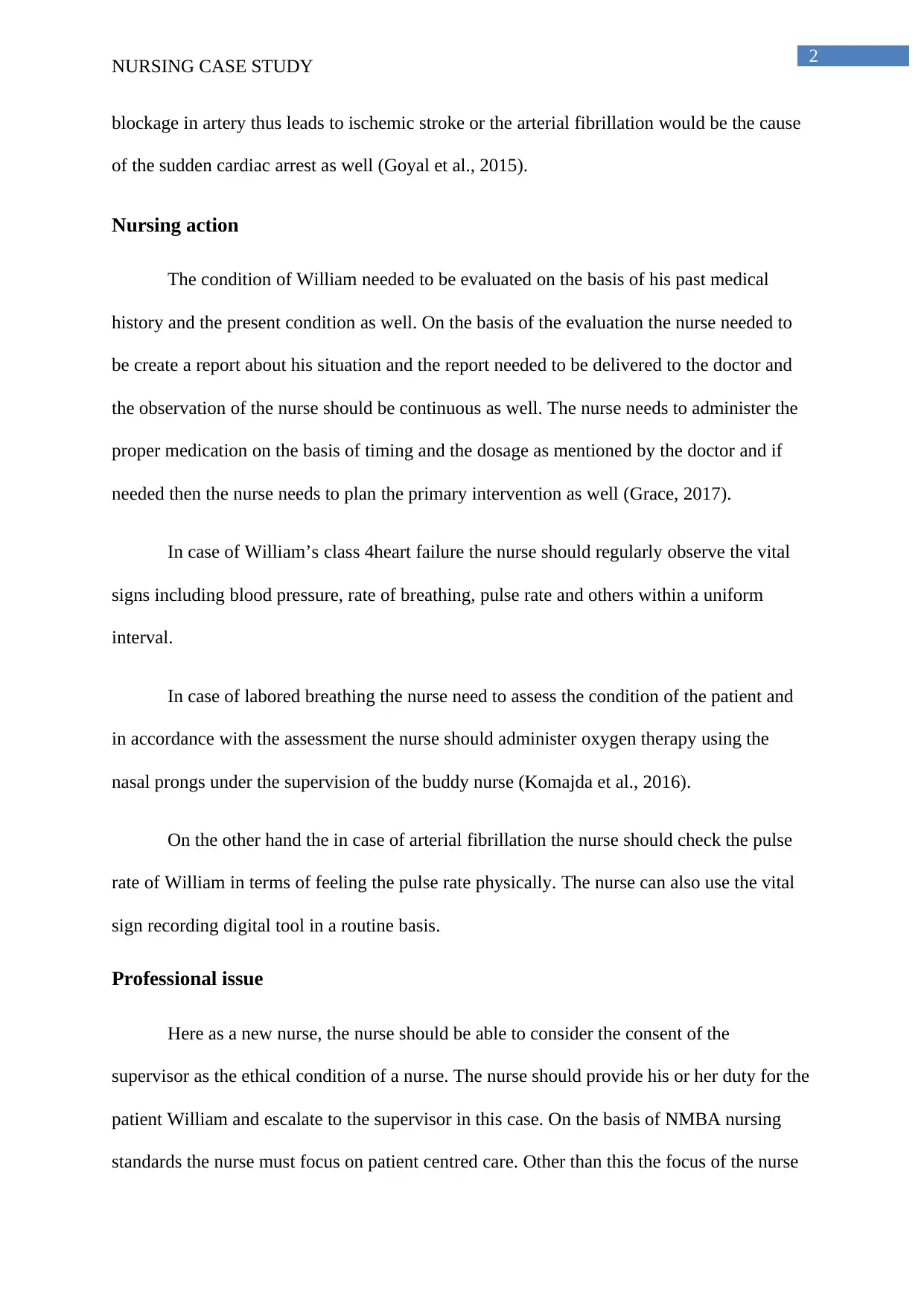
2
NURSING CASE STUDY
blockage in artery thus leads to ischemic stroke or the arterial fibrillation would be the cause
of the sudden cardiac arrest as well (Goyal et al., 2015).
Nursing action
The condition of William needed to be evaluated on the basis of his past medical
history and the present condition as well. On the basis of the evaluation the nurse needed to
be create a report about his situation and the report needed to be delivered to the doctor and
the observation of the nurse should be continuous as well. The nurse needs to administer the
proper medication on the basis of timing and the dosage as mentioned by the doctor and if
needed then the nurse needs to plan the primary intervention as well (Grace, 2017).
In case of William’s class 4heart failure the nurse should regularly observe the vital
signs including blood pressure, rate of breathing, pulse rate and others within a uniform
interval.
In case of labored breathing the nurse need to assess the condition of the patient and
in accordance with the assessment the nurse should administer oxygen therapy using the
nasal prongs under the supervision of the buddy nurse (Komajda et al., 2016).
On the other hand the in case of arterial fibrillation the nurse should check the pulse
rate of William in terms of feeling the pulse rate physically. The nurse can also use the vital
sign recording digital tool in a routine basis.
Professional issue
Here as a new nurse, the nurse should be able to consider the consent of the
supervisor as the ethical condition of a nurse. The nurse should provide his or her duty for the
patient William and escalate to the supervisor in this case. On the basis of NMBA nursing
standards the nurse must focus on patient centred care. Other than this the focus of the nurse
NURSING CASE STUDY
blockage in artery thus leads to ischemic stroke or the arterial fibrillation would be the cause
of the sudden cardiac arrest as well (Goyal et al., 2015).
Nursing action
The condition of William needed to be evaluated on the basis of his past medical
history and the present condition as well. On the basis of the evaluation the nurse needed to
be create a report about his situation and the report needed to be delivered to the doctor and
the observation of the nurse should be continuous as well. The nurse needs to administer the
proper medication on the basis of timing and the dosage as mentioned by the doctor and if
needed then the nurse needs to plan the primary intervention as well (Grace, 2017).
In case of William’s class 4heart failure the nurse should regularly observe the vital
signs including blood pressure, rate of breathing, pulse rate and others within a uniform
interval.
In case of labored breathing the nurse need to assess the condition of the patient and
in accordance with the assessment the nurse should administer oxygen therapy using the
nasal prongs under the supervision of the buddy nurse (Komajda et al., 2016).
On the other hand the in case of arterial fibrillation the nurse should check the pulse
rate of William in terms of feeling the pulse rate physically. The nurse can also use the vital
sign recording digital tool in a routine basis.
Professional issue
Here as a new nurse, the nurse should be able to consider the consent of the
supervisor as the ethical condition of a nurse. The nurse should provide his or her duty for the
patient William and escalate to the supervisor in this case. On the basis of NMBA nursing
standards the nurse must focus on patient centred care. Other than this the focus of the nurse
⊘ This is a preview!⊘
Do you want full access?
Subscribe today to unlock all pages.

Trusted by 1+ million students worldwide

3
NURSING CASE STUDY
should be on the condition along with the requirements of patient over any other aspects and
interact with compassionate behaviour with patients along with honesty, respect and integrity
to uphold professional behaviour (Nursingmidwiferyboard.gov.au, 2019). The NSQHS
standards should also be maintained which needed to be included with comprehensive care,
clinical communication, medication safety, management of pressure injuries and response to
the deterioration of the clinical situation of the patient (Safetyandquality.gov.au, 2019).
Case study 2
Pathophysiology and rationale
In the case of Carol the nursing diagnosis can be referred to three fundamental issues
which are medication induced respiratory distress, hypovolemic shock and pain 6 out of 10.
Carol also showed breathing rate 12 per minute; however, as her blood pressure is low
and the oxygen content of the blood needs to be higher in this state. Thus the breathing
distress occurs, and the causes of the respiratory distress are probably the medication along
with her hypovolemic shock and the lower blood pressure as well as the septic shock. The
coronary heart disease also could be the cause of the distress in breathing (Blondonnet,
Constantin,Sapin&Jabaudon, 2016).
Carol, old lady after her knee replacement with vital signs such as blood pressure
(BP) measured up to 90/46 mmHg, 12 breaths per minute and 90bpm pulse rate diagnosed.
On the other hand the closed suction drainage system drained 450 ml of blood from the
operation area. Based on this assessment, it can be referred to the hypovolemic condition of
Carol due to the huge amount of blood drainage from her knee (Siddall, Khatri & Radhakrishnan,
2017). Thus this situation would lead to seizing in blood transfer to all cells and tissues of
body; hence, the patient's multiple organ failure and improper tissue perfusion can be seen
(Gulati, 2016).
NURSING CASE STUDY
should be on the condition along with the requirements of patient over any other aspects and
interact with compassionate behaviour with patients along with honesty, respect and integrity
to uphold professional behaviour (Nursingmidwiferyboard.gov.au, 2019). The NSQHS
standards should also be maintained which needed to be included with comprehensive care,
clinical communication, medication safety, management of pressure injuries and response to
the deterioration of the clinical situation of the patient (Safetyandquality.gov.au, 2019).
Case study 2
Pathophysiology and rationale
In the case of Carol the nursing diagnosis can be referred to three fundamental issues
which are medication induced respiratory distress, hypovolemic shock and pain 6 out of 10.
Carol also showed breathing rate 12 per minute; however, as her blood pressure is low
and the oxygen content of the blood needs to be higher in this state. Thus the breathing
distress occurs, and the causes of the respiratory distress are probably the medication along
with her hypovolemic shock and the lower blood pressure as well as the septic shock. The
coronary heart disease also could be the cause of the distress in breathing (Blondonnet,
Constantin,Sapin&Jabaudon, 2016).
Carol, old lady after her knee replacement with vital signs such as blood pressure
(BP) measured up to 90/46 mmHg, 12 breaths per minute and 90bpm pulse rate diagnosed.
On the other hand the closed suction drainage system drained 450 ml of blood from the
operation area. Based on this assessment, it can be referred to the hypovolemic condition of
Carol due to the huge amount of blood drainage from her knee (Siddall, Khatri & Radhakrishnan,
2017). Thus this situation would lead to seizing in blood transfer to all cells and tissues of
body; hence, the patient's multiple organ failure and improper tissue perfusion can be seen
(Gulati, 2016).
Paraphrase This Document
Need a fresh take? Get an instant paraphrase of this document with our AI Paraphraser

4
NURSING CASE STUDY
Carol has a medical history of lower coagulation power to the external cuts. Her knee
replacement operation site needs blood suction for drying the site as well. Thus the risk of the
microbial attack is very much possible in her case, and the septicemia can be diagnosed along
with the factor of after operation pain (McConnell & Coopersmith, 2016). These are the
pathophysiology of Carol’s acute pain that measured as 6 out of 10. In the case of Carol, the
nurse found she was dizzy and weak. Her breathing rate was low as well, which would be
leading to low blood pressure. The blood flow of the body would be deficient thus lack of
blood perfusion in the tissues would be imbalanced, and this condition could lead to the death
of the patient (Hotchkiss, Moldawer, Opal, Reinhart, Turnbull& Vincent, 2016).
Nursing action
In case of respiratory distress the nurse should diagnose the factor and use the oxygen
therapy for the sustainability of the patient by using the nasal prongs.
On the other hand in case of hypovolemic shock the nurse should monitor the vital
signs of Carol and also need to monitor the blood loss from the operation site by means of the
suction process. Other than this the nurse should also review the medication process of the
patient in order to prevent the hypovolemic condition of the patient.
The pain of Carol also needed to be addressed by the nurse by means of the
medication review and the checking of current condition. The efficiency of the current
treatment in terms of Carol’s betterment needed to analysed by the nurse and needed to be
conveyed to the supervisor or doctor for the better treatment of the patient (Oldenburg et al.,
2017).
NURSING CASE STUDY
Carol has a medical history of lower coagulation power to the external cuts. Her knee
replacement operation site needs blood suction for drying the site as well. Thus the risk of the
microbial attack is very much possible in her case, and the septicemia can be diagnosed along
with the factor of after operation pain (McConnell & Coopersmith, 2016). These are the
pathophysiology of Carol’s acute pain that measured as 6 out of 10. In the case of Carol, the
nurse found she was dizzy and weak. Her breathing rate was low as well, which would be
leading to low blood pressure. The blood flow of the body would be deficient thus lack of
blood perfusion in the tissues would be imbalanced, and this condition could lead to the death
of the patient (Hotchkiss, Moldawer, Opal, Reinhart, Turnbull& Vincent, 2016).
Nursing action
In case of respiratory distress the nurse should diagnose the factor and use the oxygen
therapy for the sustainability of the patient by using the nasal prongs.
On the other hand in case of hypovolemic shock the nurse should monitor the vital
signs of Carol and also need to monitor the blood loss from the operation site by means of the
suction process. Other than this the nurse should also review the medication process of the
patient in order to prevent the hypovolemic condition of the patient.
The pain of Carol also needed to be addressed by the nurse by means of the
medication review and the checking of current condition. The efficiency of the current
treatment in terms of Carol’s betterment needed to analysed by the nurse and needed to be
conveyed to the supervisor or doctor for the better treatment of the patient (Oldenburg et al.,
2017).
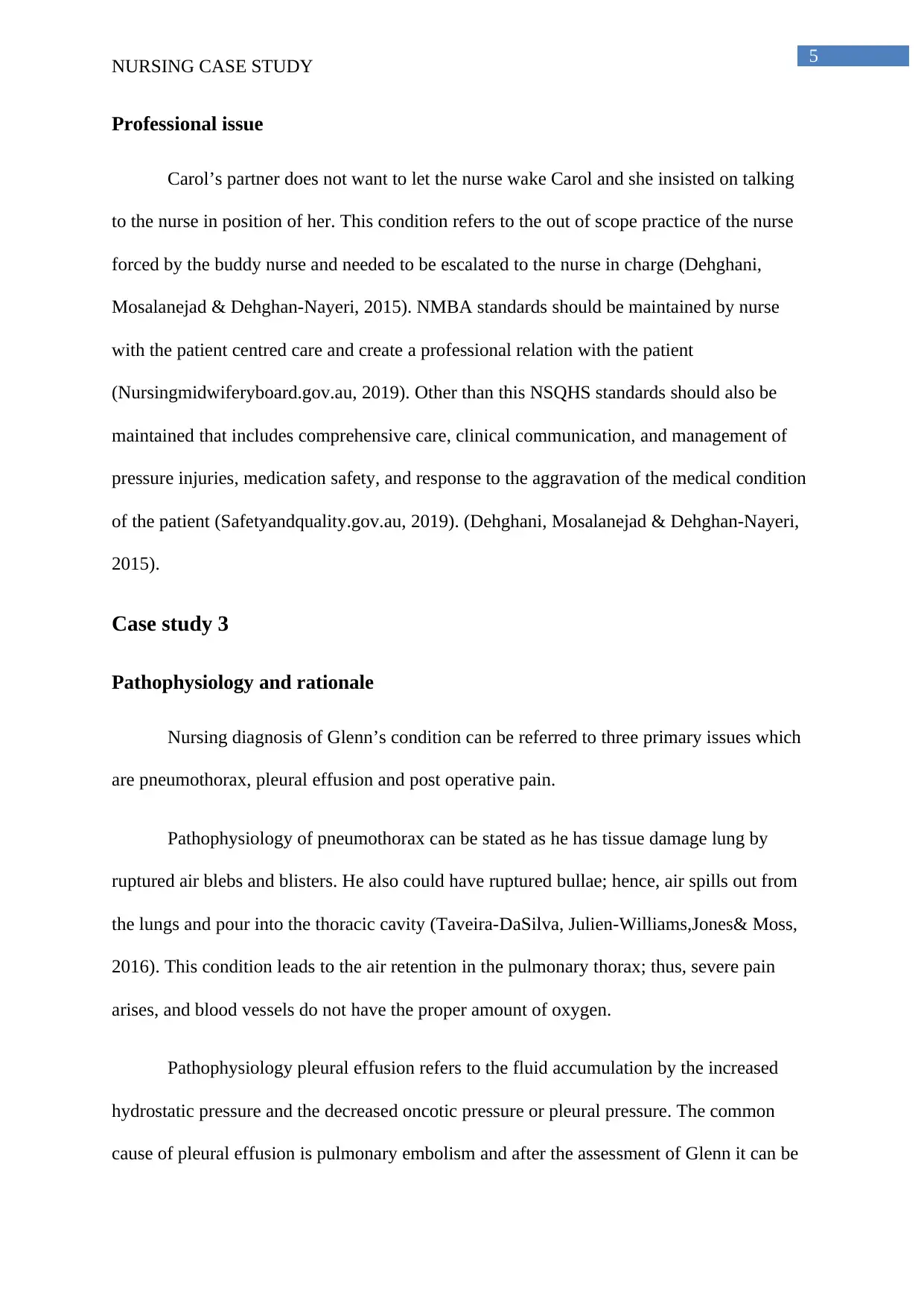
5
NURSING CASE STUDY
Professional issue
Carol’s partner does not want to let the nurse wake Carol and she insisted on talking
to the nurse in position of her. This condition refers to the out of scope practice of the nurse
forced by the buddy nurse and needed to be escalated to the nurse in charge (Dehghani,
Mosalanejad & Dehghan-Nayeri, 2015). NMBA standards should be maintained by nurse
with the patient centred care and create a professional relation with the patient
(Nursingmidwiferyboard.gov.au, 2019). Other than this NSQHS standards should also be
maintained that includes comprehensive care, clinical communication, and management of
pressure injuries, medication safety, and response to the aggravation of the medical condition
of the patient (Safetyandquality.gov.au, 2019). (Dehghani, Mosalanejad & Dehghan-Nayeri,
2015).
Case study 3
Pathophysiology and rationale
Nursing diagnosis of Glenn’s condition can be referred to three primary issues which
are pneumothorax, pleural effusion and post operative pain.
Pathophysiology of pneumothorax can be stated as he has tissue damage lung by
ruptured air blebs and blisters. He also could have ruptured bullae; hence, air spills out from
the lungs and pour into the thoracic cavity (Taveira-DaSilva, Julien-Williams,Jones& Moss,
2016). This condition leads to the air retention in the pulmonary thorax; thus, severe pain
arises, and blood vessels do not have the proper amount of oxygen.
Pathophysiology pleural effusion refers to the fluid accumulation by the increased
hydrostatic pressure and the decreased oncotic pressure or pleural pressure. The common
cause of pleural effusion is pulmonary embolism and after the assessment of Glenn it can be
NURSING CASE STUDY
Professional issue
Carol’s partner does not want to let the nurse wake Carol and she insisted on talking
to the nurse in position of her. This condition refers to the out of scope practice of the nurse
forced by the buddy nurse and needed to be escalated to the nurse in charge (Dehghani,
Mosalanejad & Dehghan-Nayeri, 2015). NMBA standards should be maintained by nurse
with the patient centred care and create a professional relation with the patient
(Nursingmidwiferyboard.gov.au, 2019). Other than this NSQHS standards should also be
maintained that includes comprehensive care, clinical communication, and management of
pressure injuries, medication safety, and response to the aggravation of the medical condition
of the patient (Safetyandquality.gov.au, 2019). (Dehghani, Mosalanejad & Dehghan-Nayeri,
2015).
Case study 3
Pathophysiology and rationale
Nursing diagnosis of Glenn’s condition can be referred to three primary issues which
are pneumothorax, pleural effusion and post operative pain.
Pathophysiology of pneumothorax can be stated as he has tissue damage lung by
ruptured air blebs and blisters. He also could have ruptured bullae; hence, air spills out from
the lungs and pour into the thoracic cavity (Taveira-DaSilva, Julien-Williams,Jones& Moss,
2016). This condition leads to the air retention in the pulmonary thorax; thus, severe pain
arises, and blood vessels do not have the proper amount of oxygen.
Pathophysiology pleural effusion refers to the fluid accumulation by the increased
hydrostatic pressure and the decreased oncotic pressure or pleural pressure. The common
cause of pleural effusion is pulmonary embolism and after the assessment of Glenn it can be
⊘ This is a preview!⊘
Do you want full access?
Subscribe today to unlock all pages.

Trusted by 1+ million students worldwide
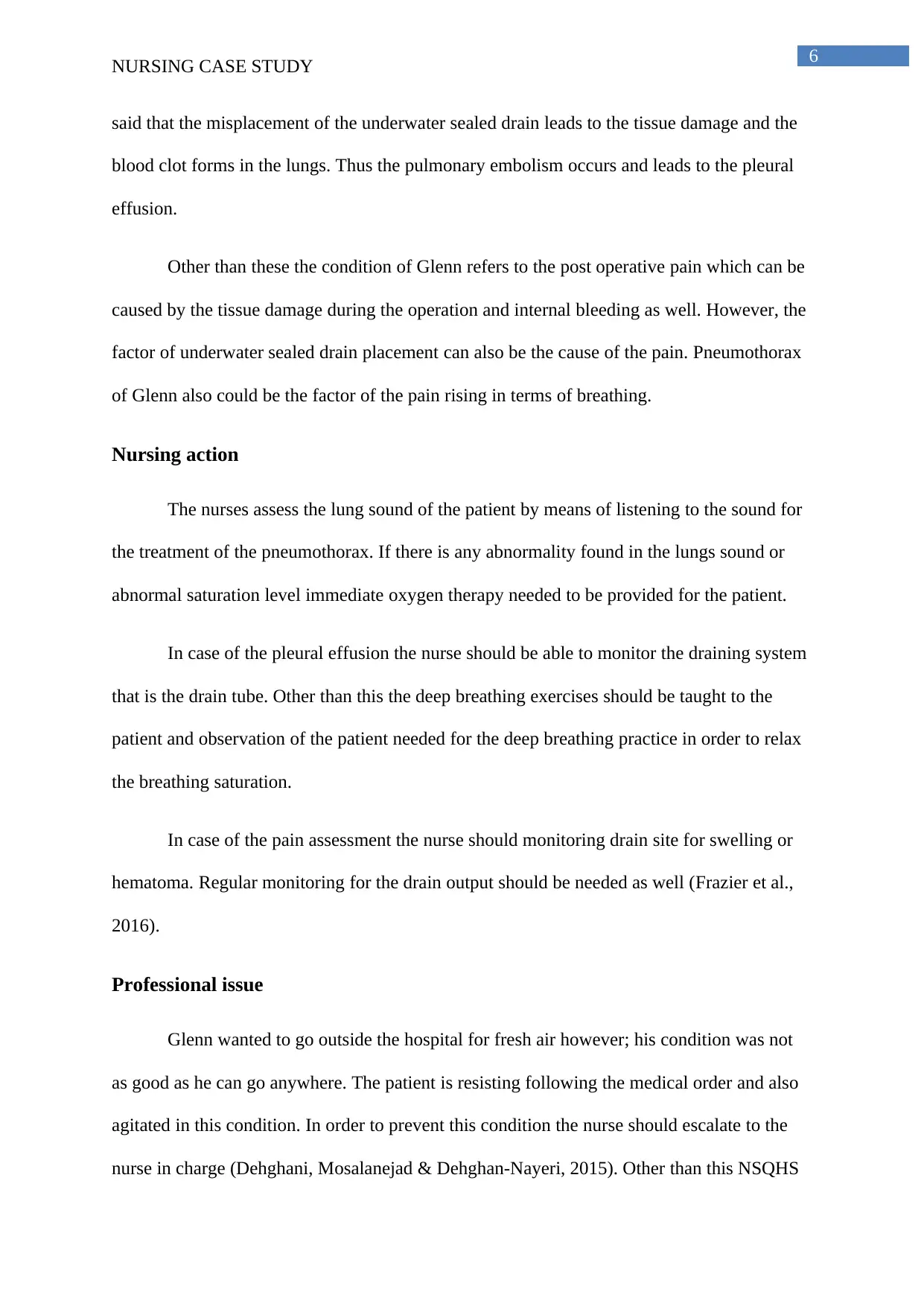
6
NURSING CASE STUDY
said that the misplacement of the underwater sealed drain leads to the tissue damage and the
blood clot forms in the lungs. Thus the pulmonary embolism occurs and leads to the pleural
effusion.
Other than these the condition of Glenn refers to the post operative pain which can be
caused by the tissue damage during the operation and internal bleeding as well. However, the
factor of underwater sealed drain placement can also be the cause of the pain. Pneumothorax
of Glenn also could be the factor of the pain rising in terms of breathing.
Nursing action
The nurses assess the lung sound of the patient by means of listening to the sound for
the treatment of the pneumothorax. If there is any abnormality found in the lungs sound or
abnormal saturation level immediate oxygen therapy needed to be provided for the patient.
In case of the pleural effusion the nurse should be able to monitor the draining system
that is the drain tube. Other than this the deep breathing exercises should be taught to the
patient and observation of the patient needed for the deep breathing practice in order to relax
the breathing saturation.
In case of the pain assessment the nurse should monitoring drain site for swelling or
hematoma. Regular monitoring for the drain output should be needed as well (Frazier et al.,
2016).
Professional issue
Glenn wanted to go outside the hospital for fresh air however; his condition was not
as good as he can go anywhere. The patient is resisting following the medical order and also
agitated in this condition. In order to prevent this condition the nurse should escalate to the
nurse in charge (Dehghani, Mosalanejad & Dehghan-Nayeri, 2015). Other than this NSQHS
NURSING CASE STUDY
said that the misplacement of the underwater sealed drain leads to the tissue damage and the
blood clot forms in the lungs. Thus the pulmonary embolism occurs and leads to the pleural
effusion.
Other than these the condition of Glenn refers to the post operative pain which can be
caused by the tissue damage during the operation and internal bleeding as well. However, the
factor of underwater sealed drain placement can also be the cause of the pain. Pneumothorax
of Glenn also could be the factor of the pain rising in terms of breathing.
Nursing action
The nurses assess the lung sound of the patient by means of listening to the sound for
the treatment of the pneumothorax. If there is any abnormality found in the lungs sound or
abnormal saturation level immediate oxygen therapy needed to be provided for the patient.
In case of the pleural effusion the nurse should be able to monitor the draining system
that is the drain tube. Other than this the deep breathing exercises should be taught to the
patient and observation of the patient needed for the deep breathing practice in order to relax
the breathing saturation.
In case of the pain assessment the nurse should monitoring drain site for swelling or
hematoma. Regular monitoring for the drain output should be needed as well (Frazier et al.,
2016).
Professional issue
Glenn wanted to go outside the hospital for fresh air however; his condition was not
as good as he can go anywhere. The patient is resisting following the medical order and also
agitated in this condition. In order to prevent this condition the nurse should escalate to the
nurse in charge (Dehghani, Mosalanejad & Dehghan-Nayeri, 2015). Other than this NSQHS
Paraphrase This Document
Need a fresh take? Get an instant paraphrase of this document with our AI Paraphraser
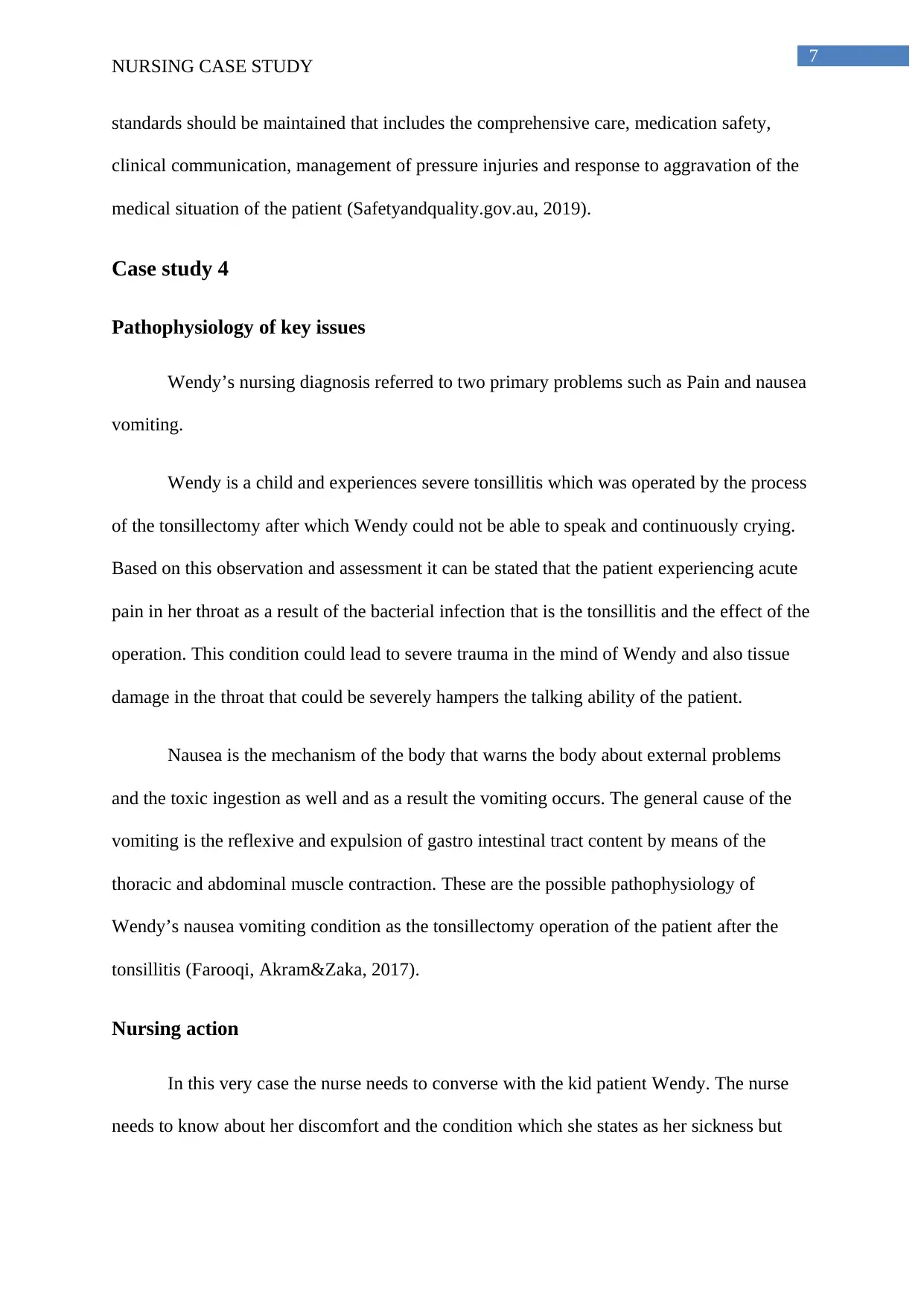
7
NURSING CASE STUDY
standards should be maintained that includes the comprehensive care, medication safety,
clinical communication, management of pressure injuries and response to aggravation of the
medical situation of the patient (Safetyandquality.gov.au, 2019).
Case study 4
Pathophysiology of key issues
Wendy’s nursing diagnosis referred to two primary problems such as Pain and nausea
vomiting.
Wendy is a child and experiences severe tonsillitis which was operated by the process
of the tonsillectomy after which Wendy could not be able to speak and continuously crying.
Based on this observation and assessment it can be stated that the patient experiencing acute
pain in her throat as a result of the bacterial infection that is the tonsillitis and the effect of the
operation. This condition could lead to severe trauma in the mind of Wendy and also tissue
damage in the throat that could be severely hampers the talking ability of the patient.
Nausea is the mechanism of the body that warns the body about external problems
and the toxic ingestion as well and as a result the vomiting occurs. The general cause of the
vomiting is the reflexive and expulsion of gastro intestinal tract content by means of the
thoracic and abdominal muscle contraction. These are the possible pathophysiology of
Wendy’s nausea vomiting condition as the tonsillectomy operation of the patient after the
tonsillitis (Farooqi, Akram&Zaka, 2017).
Nursing action
In this very case the nurse needs to converse with the kid patient Wendy. The nurse
needs to know about her discomfort and the condition which she states as her sickness but
NURSING CASE STUDY
standards should be maintained that includes the comprehensive care, medication safety,
clinical communication, management of pressure injuries and response to aggravation of the
medical situation of the patient (Safetyandquality.gov.au, 2019).
Case study 4
Pathophysiology of key issues
Wendy’s nursing diagnosis referred to two primary problems such as Pain and nausea
vomiting.
Wendy is a child and experiences severe tonsillitis which was operated by the process
of the tonsillectomy after which Wendy could not be able to speak and continuously crying.
Based on this observation and assessment it can be stated that the patient experiencing acute
pain in her throat as a result of the bacterial infection that is the tonsillitis and the effect of the
operation. This condition could lead to severe trauma in the mind of Wendy and also tissue
damage in the throat that could be severely hampers the talking ability of the patient.
Nausea is the mechanism of the body that warns the body about external problems
and the toxic ingestion as well and as a result the vomiting occurs. The general cause of the
vomiting is the reflexive and expulsion of gastro intestinal tract content by means of the
thoracic and abdominal muscle contraction. These are the possible pathophysiology of
Wendy’s nausea vomiting condition as the tonsillectomy operation of the patient after the
tonsillitis (Farooqi, Akram&Zaka, 2017).
Nursing action
In this very case the nurse needs to converse with the kid patient Wendy. The nurse
needs to know about her discomfort and the condition which she states as her sickness but
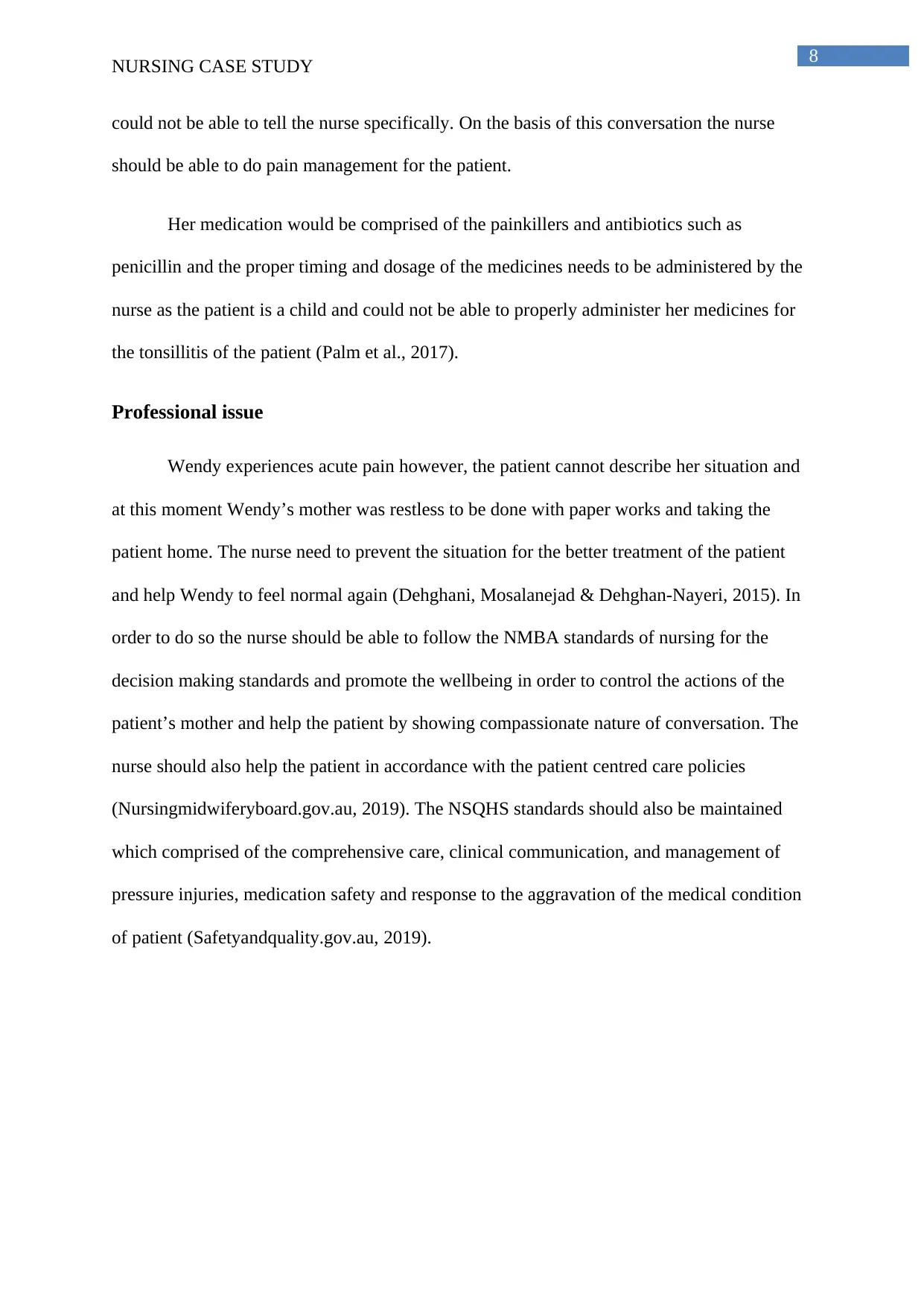
8
NURSING CASE STUDY
could not be able to tell the nurse specifically. On the basis of this conversation the nurse
should be able to do pain management for the patient.
Her medication would be comprised of the painkillers and antibiotics such as
penicillin and the proper timing and dosage of the medicines needs to be administered by the
nurse as the patient is a child and could not be able to properly administer her medicines for
the tonsillitis of the patient (Palm et al., 2017).
Professional issue
Wendy experiences acute pain however, the patient cannot describe her situation and
at this moment Wendy’s mother was restless to be done with paper works and taking the
patient home. The nurse need to prevent the situation for the better treatment of the patient
and help Wendy to feel normal again (Dehghani, Mosalanejad & Dehghan-Nayeri, 2015). In
order to do so the nurse should be able to follow the NMBA standards of nursing for the
decision making standards and promote the wellbeing in order to control the actions of the
patient’s mother and help the patient by showing compassionate nature of conversation. The
nurse should also help the patient in accordance with the patient centred care policies
(Nursingmidwiferyboard.gov.au, 2019). The NSQHS standards should also be maintained
which comprised of the comprehensive care, clinical communication, and management of
pressure injuries, medication safety and response to the aggravation of the medical condition
of patient (Safetyandquality.gov.au, 2019).
NURSING CASE STUDY
could not be able to tell the nurse specifically. On the basis of this conversation the nurse
should be able to do pain management for the patient.
Her medication would be comprised of the painkillers and antibiotics such as
penicillin and the proper timing and dosage of the medicines needs to be administered by the
nurse as the patient is a child and could not be able to properly administer her medicines for
the tonsillitis of the patient (Palm et al., 2017).
Professional issue
Wendy experiences acute pain however, the patient cannot describe her situation and
at this moment Wendy’s mother was restless to be done with paper works and taking the
patient home. The nurse need to prevent the situation for the better treatment of the patient
and help Wendy to feel normal again (Dehghani, Mosalanejad & Dehghan-Nayeri, 2015). In
order to do so the nurse should be able to follow the NMBA standards of nursing for the
decision making standards and promote the wellbeing in order to control the actions of the
patient’s mother and help the patient by showing compassionate nature of conversation. The
nurse should also help the patient in accordance with the patient centred care policies
(Nursingmidwiferyboard.gov.au, 2019). The NSQHS standards should also be maintained
which comprised of the comprehensive care, clinical communication, and management of
pressure injuries, medication safety and response to the aggravation of the medical condition
of patient (Safetyandquality.gov.au, 2019).
⊘ This is a preview!⊘
Do you want full access?
Subscribe today to unlock all pages.

Trusted by 1+ million students worldwide
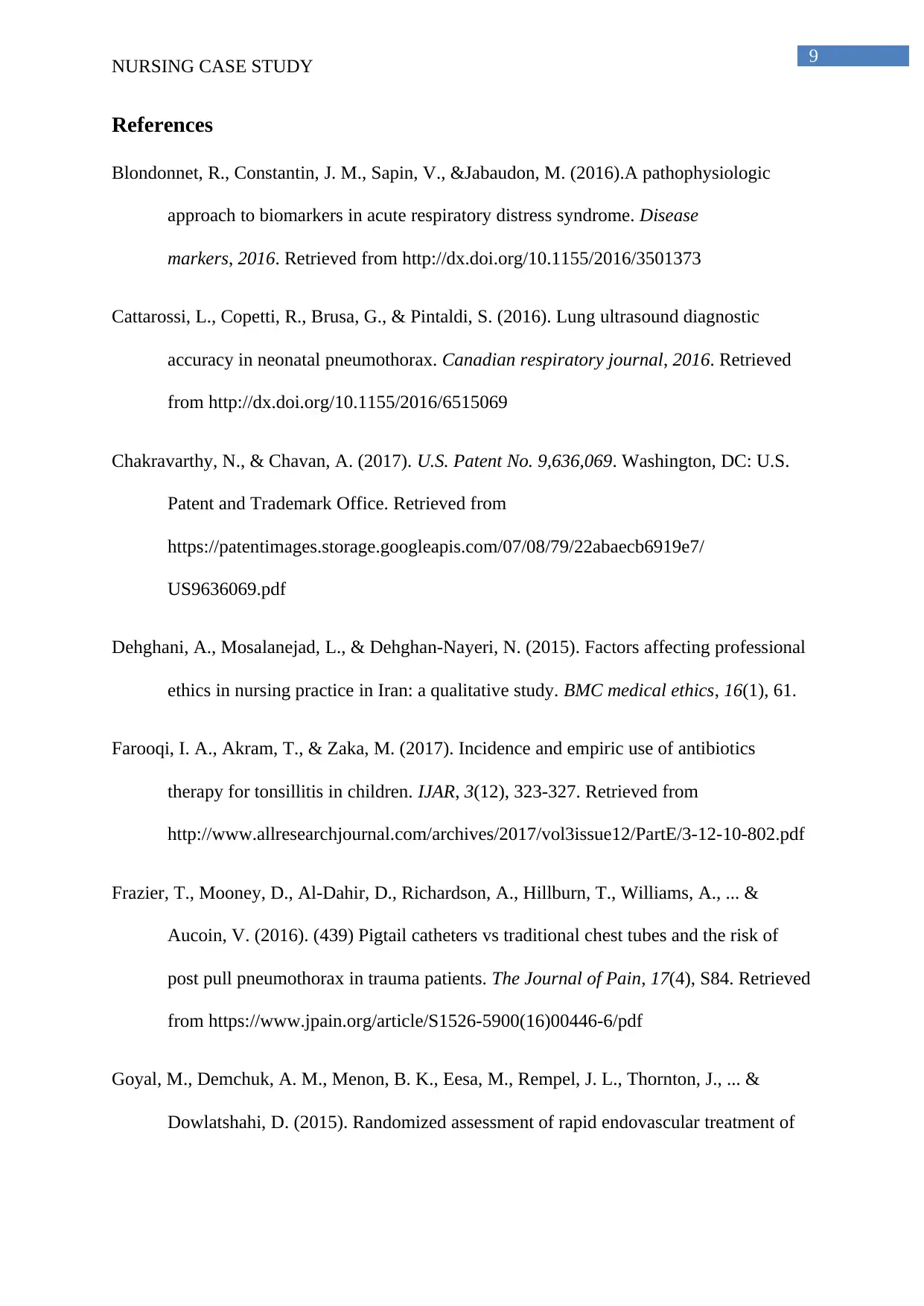
9
NURSING CASE STUDY
References
Blondonnet, R., Constantin, J. M., Sapin, V., &Jabaudon, M. (2016).A pathophysiologic
approach to biomarkers in acute respiratory distress syndrome. Disease
markers, 2016. Retrieved from http://dx.doi.org/10.1155/2016/3501373
Cattarossi, L., Copetti, R., Brusa, G., & Pintaldi, S. (2016). Lung ultrasound diagnostic
accuracy in neonatal pneumothorax. Canadian respiratory journal, 2016. Retrieved
from http://dx.doi.org/10.1155/2016/6515069
Chakravarthy, N., & Chavan, A. (2017). U.S. Patent No. 9,636,069. Washington, DC: U.S.
Patent and Trademark Office. Retrieved from
https://patentimages.storage.googleapis.com/07/08/79/22abaecb6919e7/
US9636069.pdf
Dehghani, A., Mosalanejad, L., & Dehghan-Nayeri, N. (2015). Factors affecting professional
ethics in nursing practice in Iran: a qualitative study. BMC medical ethics, 16(1), 61.
Farooqi, I. A., Akram, T., & Zaka, M. (2017). Incidence and empiric use of antibiotics
therapy for tonsillitis in children. IJAR, 3(12), 323-327. Retrieved from
http://www.allresearchjournal.com/archives/2017/vol3issue12/PartE/3-12-10-802.pdf
Frazier, T., Mooney, D., Al-Dahir, D., Richardson, A., Hillburn, T., Williams, A., ... &
Aucoin, V. (2016). (439) Pigtail catheters vs traditional chest tubes and the risk of
post pull pneumothorax in trauma patients. The Journal of Pain, 17(4), S84. Retrieved
from https://www.jpain.org/article/S1526-5900(16)00446-6/pdf
Goyal, M., Demchuk, A. M., Menon, B. K., Eesa, M., Rempel, J. L., Thornton, J., ... &
Dowlatshahi, D. (2015). Randomized assessment of rapid endovascular treatment of
NURSING CASE STUDY
References
Blondonnet, R., Constantin, J. M., Sapin, V., &Jabaudon, M. (2016).A pathophysiologic
approach to biomarkers in acute respiratory distress syndrome. Disease
markers, 2016. Retrieved from http://dx.doi.org/10.1155/2016/3501373
Cattarossi, L., Copetti, R., Brusa, G., & Pintaldi, S. (2016). Lung ultrasound diagnostic
accuracy in neonatal pneumothorax. Canadian respiratory journal, 2016. Retrieved
from http://dx.doi.org/10.1155/2016/6515069
Chakravarthy, N., & Chavan, A. (2017). U.S. Patent No. 9,636,069. Washington, DC: U.S.
Patent and Trademark Office. Retrieved from
https://patentimages.storage.googleapis.com/07/08/79/22abaecb6919e7/
US9636069.pdf
Dehghani, A., Mosalanejad, L., & Dehghan-Nayeri, N. (2015). Factors affecting professional
ethics in nursing practice in Iran: a qualitative study. BMC medical ethics, 16(1), 61.
Farooqi, I. A., Akram, T., & Zaka, M. (2017). Incidence and empiric use of antibiotics
therapy for tonsillitis in children. IJAR, 3(12), 323-327. Retrieved from
http://www.allresearchjournal.com/archives/2017/vol3issue12/PartE/3-12-10-802.pdf
Frazier, T., Mooney, D., Al-Dahir, D., Richardson, A., Hillburn, T., Williams, A., ... &
Aucoin, V. (2016). (439) Pigtail catheters vs traditional chest tubes and the risk of
post pull pneumothorax in trauma patients. The Journal of Pain, 17(4), S84. Retrieved
from https://www.jpain.org/article/S1526-5900(16)00446-6/pdf
Goyal, M., Demchuk, A. M., Menon, B. K., Eesa, M., Rempel, J. L., Thornton, J., ... &
Dowlatshahi, D. (2015). Randomized assessment of rapid endovascular treatment of
Paraphrase This Document
Need a fresh take? Get an instant paraphrase of this document with our AI Paraphraser
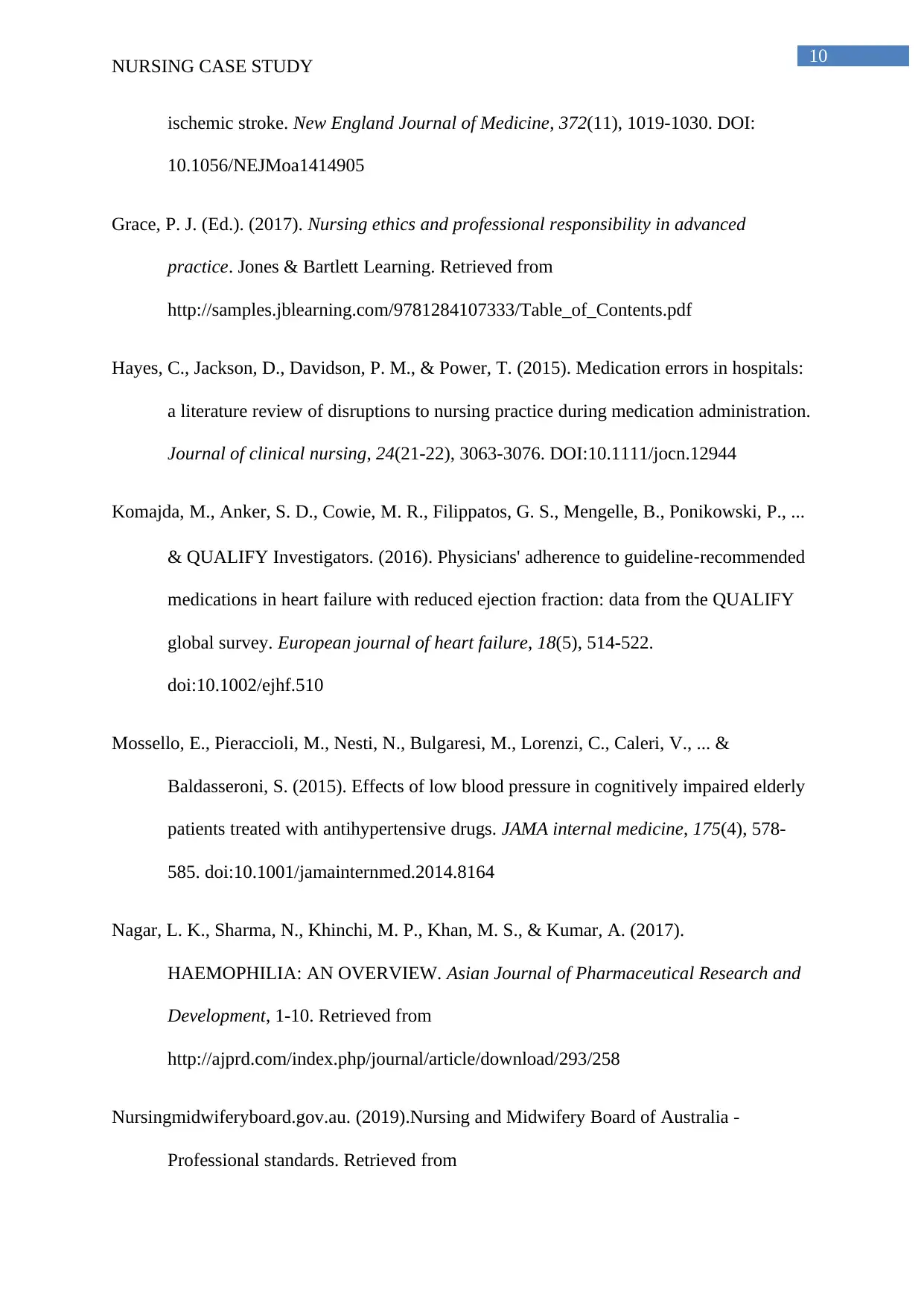
10
NURSING CASE STUDY
ischemic stroke. New England Journal of Medicine, 372(11), 1019-1030. DOI:
10.1056/NEJMoa1414905
Grace, P. J. (Ed.). (2017). Nursing ethics and professional responsibility in advanced
practice. Jones & Bartlett Learning. Retrieved from
http://samples.jblearning.com/9781284107333/Table_of_Contents.pdf
Hayes, C., Jackson, D., Davidson, P. M., & Power, T. (2015). Medication errors in hospitals:
a literature review of disruptions to nursing practice during medication administration.
Journal of clinical nursing, 24(21-22), 3063-3076. DOI:10.1111/jocn.12944
Komajda, M., Anker, S. D., Cowie, M. R., Filippatos, G. S., Mengelle, B., Ponikowski, P., ...
& QUALIFY Investigators. (2016). Physicians' adherence to guideline‐recommended
medications in heart failure with reduced ejection fraction: data from the QUALIFY
global survey. European journal of heart failure, 18(5), 514-522.
doi:10.1002/ejhf.510
Mossello, E., Pieraccioli, M., Nesti, N., Bulgaresi, M., Lorenzi, C., Caleri, V., ... &
Baldasseroni, S. (2015). Effects of low blood pressure in cognitively impaired elderly
patients treated with antihypertensive drugs. JAMA internal medicine, 175(4), 578-
585. doi:10.1001/jamainternmed.2014.8164
Nagar, L. K., Sharma, N., Khinchi, M. P., Khan, M. S., & Kumar, A. (2017).
HAEMOPHILIA: AN OVERVIEW. Asian Journal of Pharmaceutical Research and
Development, 1-10. Retrieved from
http://ajprd.com/index.php/journal/article/download/293/258
Nursingmidwiferyboard.gov.au. (2019).Nursing and Midwifery Board of Australia -
Professional standards. Retrieved from
NURSING CASE STUDY
ischemic stroke. New England Journal of Medicine, 372(11), 1019-1030. DOI:
10.1056/NEJMoa1414905
Grace, P. J. (Ed.). (2017). Nursing ethics and professional responsibility in advanced
practice. Jones & Bartlett Learning. Retrieved from
http://samples.jblearning.com/9781284107333/Table_of_Contents.pdf
Hayes, C., Jackson, D., Davidson, P. M., & Power, T. (2015). Medication errors in hospitals:
a literature review of disruptions to nursing practice during medication administration.
Journal of clinical nursing, 24(21-22), 3063-3076. DOI:10.1111/jocn.12944
Komajda, M., Anker, S. D., Cowie, M. R., Filippatos, G. S., Mengelle, B., Ponikowski, P., ...
& QUALIFY Investigators. (2016). Physicians' adherence to guideline‐recommended
medications in heart failure with reduced ejection fraction: data from the QUALIFY
global survey. European journal of heart failure, 18(5), 514-522.
doi:10.1002/ejhf.510
Mossello, E., Pieraccioli, M., Nesti, N., Bulgaresi, M., Lorenzi, C., Caleri, V., ... &
Baldasseroni, S. (2015). Effects of low blood pressure in cognitively impaired elderly
patients treated with antihypertensive drugs. JAMA internal medicine, 175(4), 578-
585. doi:10.1001/jamainternmed.2014.8164
Nagar, L. K., Sharma, N., Khinchi, M. P., Khan, M. S., & Kumar, A. (2017).
HAEMOPHILIA: AN OVERVIEW. Asian Journal of Pharmaceutical Research and
Development, 1-10. Retrieved from
http://ajprd.com/index.php/journal/article/download/293/258
Nursingmidwiferyboard.gov.au. (2019).Nursing and Midwifery Board of Australia -
Professional standards. Retrieved from
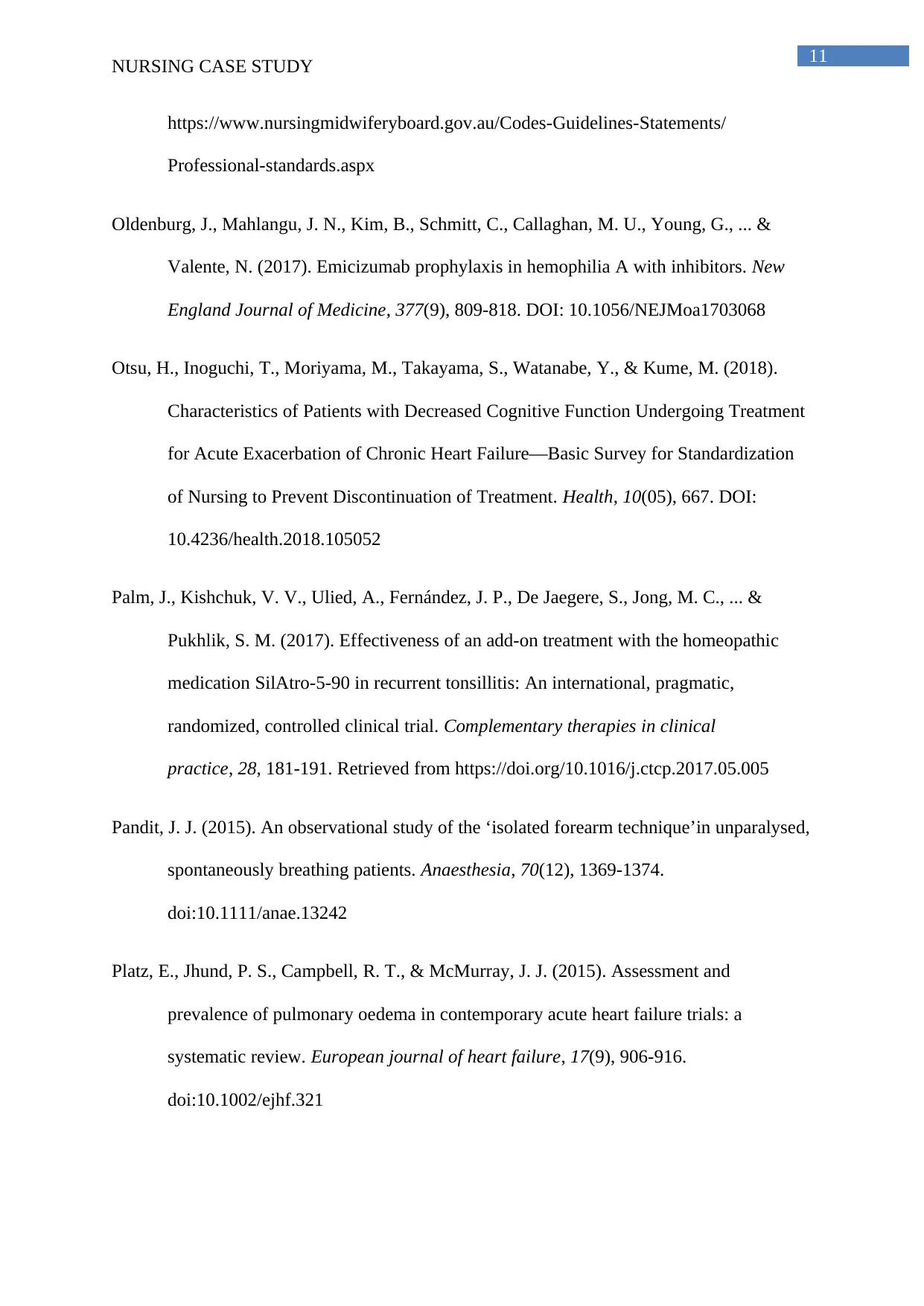
11
NURSING CASE STUDY
https://www.nursingmidwiferyboard.gov.au/Codes-Guidelines-Statements/
Professional-standards.aspx
Oldenburg, J., Mahlangu, J. N., Kim, B., Schmitt, C., Callaghan, M. U., Young, G., ... &
Valente, N. (2017). Emicizumab prophylaxis in hemophilia A with inhibitors. New
England Journal of Medicine, 377(9), 809-818. DOI: 10.1056/NEJMoa1703068
Otsu, H., Inoguchi, T., Moriyama, M., Takayama, S., Watanabe, Y., & Kume, M. (2018).
Characteristics of Patients with Decreased Cognitive Function Undergoing Treatment
for Acute Exacerbation of Chronic Heart Failure—Basic Survey for Standardization
of Nursing to Prevent Discontinuation of Treatment. Health, 10(05), 667. DOI:
10.4236/health.2018.105052
Palm, J., Kishchuk, V. V., Ulied, A., Fernández, J. P., De Jaegere, S., Jong, M. C., ... &
Pukhlik, S. M. (2017). Effectiveness of an add-on treatment with the homeopathic
medication SilAtro-5-90 in recurrent tonsillitis: An international, pragmatic,
randomized, controlled clinical trial. Complementary therapies in clinical
practice, 28, 181-191. Retrieved from https://doi.org/10.1016/j.ctcp.2017.05.005
Pandit, J. J. (2015). An observational study of the ‘isolated forearm technique’in unparalysed,
spontaneously breathing patients. Anaesthesia, 70(12), 1369-1374.
doi:10.1111/anae.13242
Platz, E., Jhund, P. S., Campbell, R. T., & McMurray, J. J. (2015). Assessment and
prevalence of pulmonary oedema in contemporary acute heart failure trials: a
systematic review. European journal of heart failure, 17(9), 906-916.
doi:10.1002/ejhf.321
NURSING CASE STUDY
https://www.nursingmidwiferyboard.gov.au/Codes-Guidelines-Statements/
Professional-standards.aspx
Oldenburg, J., Mahlangu, J. N., Kim, B., Schmitt, C., Callaghan, M. U., Young, G., ... &
Valente, N. (2017). Emicizumab prophylaxis in hemophilia A with inhibitors. New
England Journal of Medicine, 377(9), 809-818. DOI: 10.1056/NEJMoa1703068
Otsu, H., Inoguchi, T., Moriyama, M., Takayama, S., Watanabe, Y., & Kume, M. (2018).
Characteristics of Patients with Decreased Cognitive Function Undergoing Treatment
for Acute Exacerbation of Chronic Heart Failure—Basic Survey for Standardization
of Nursing to Prevent Discontinuation of Treatment. Health, 10(05), 667. DOI:
10.4236/health.2018.105052
Palm, J., Kishchuk, V. V., Ulied, A., Fernández, J. P., De Jaegere, S., Jong, M. C., ... &
Pukhlik, S. M. (2017). Effectiveness of an add-on treatment with the homeopathic
medication SilAtro-5-90 in recurrent tonsillitis: An international, pragmatic,
randomized, controlled clinical trial. Complementary therapies in clinical
practice, 28, 181-191. Retrieved from https://doi.org/10.1016/j.ctcp.2017.05.005
Pandit, J. J. (2015). An observational study of the ‘isolated forearm technique’in unparalysed,
spontaneously breathing patients. Anaesthesia, 70(12), 1369-1374.
doi:10.1111/anae.13242
Platz, E., Jhund, P. S., Campbell, R. T., & McMurray, J. J. (2015). Assessment and
prevalence of pulmonary oedema in contemporary acute heart failure trials: a
systematic review. European journal of heart failure, 17(9), 906-916.
doi:10.1002/ejhf.321
⊘ This is a preview!⊘
Do you want full access?
Subscribe today to unlock all pages.

Trusted by 1+ million students worldwide
1 out of 13
Related Documents
Your All-in-One AI-Powered Toolkit for Academic Success.
+13062052269
info@desklib.com
Available 24*7 on WhatsApp / Email
![[object Object]](/_next/static/media/star-bottom.7253800d.svg)
Unlock your academic potential
Copyright © 2020–2025 A2Z Services. All Rights Reserved. Developed and managed by ZUCOL.





